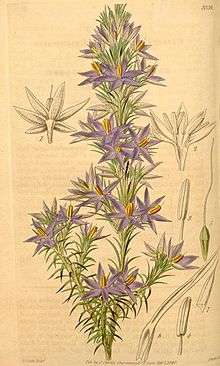Calectasia
| Tinsel lilies | |
|---|---|
 | |
| Calectasia cyanea 1841 illustration[1] | |
| Scientific classification | |
| Kingdom: | Plantae |
| (unranked): | Angiosperms |
| (unranked): | Monocots |
| (unranked): | Commelinids |
| Order: | Arecales |
| Family: | Dasypogonaceae |
| Genus: | Calectasia R.Br |
| Synonyms[2] | |
Calectasia is a genus of flowering plants in the family Dasypogonaceae. They are commonly referred to as tinsel lilies, and are endemic to southern Australia.
Description
Plants in the genus Calectasia are small, branched shrubs to about 50 cm high with stiff, erect branchlets covered by old leaves and leaf sheaths. The branchlets are covered with short, soft hairs and the lance-shaped leaves have pointed ends and parallel veins.
Flowers occur singly on the ends of short branchlets above a large number of small, overlapping leaves. They have six lilac-blue to purple petals (strictly tepals) which form a short tube at their lower end but mostly spreading, forming a star-like pattern with a metallic sheen. Six bright yellow or orange stamens form a tube in the centre of the flower with a thin style extending beyond the centre of the tube.[3]
Some species of Calectasia form specialised roots called stilt roots and can only regenerate from seed whilst others have tubers and can resprout from these. All stilt-rooted species are thought to be killed by fire and need up to five years without fire to flower and set seed.[4]
Taxonomy and naming
The first species to be named was Calectasia cyanea by Robert Brown in Prodromus Florae Novae Hollandiae et Insulae Van Diemen (page 263).[5] The name is derived from the Ancient Greek words kalos " beautiful" and ektasis "development", alluding to the blue spreading perianth-tubes.[6]
Earlier authors such as George Bentham recognised only one species (C. cyanea) but later botanists added C. grandiflora and C. intermedia. In 2001, Barrett and Dixon reviewed the genus and added eight new species[4] and in 2015 four more species were added making a total of 15.[7]
Distribution and habitat
Calectasia species occur in the south-west of Western Australia and in the border areas between South Australia and Victoria. C. intermedia is only found in the latter region and the remaining species only in Western Australia. They occupy a variety of habitats, occasionally in seasonally swampy areas, but more usually in low heath or woodland on sand, or over laterite or granite.[8]
Ecology
There is evidence that all Calectasia species have sand-binding roots and flowers that are buzz pollinated. It is possible that the similarity in appearance of Calectasia and Thelymitra variegata flowers indicate an example of Dodsonian mimicry. Calectasia grandiflora and Thelymitra variegata often occur in the same area. Individual Calectasia plants are often parasitised by a dodder-like plant in the Cassytha genus.[4]
Species
- Calectasia browneana Keighery, K.W.Dixon & R.L.Barrett
- Calectasia cyanea R.Br. - Star of Bethlehem
- Calectasia demarzii R.L.Barrett - Demarz's tinsel lily
- Calectasia elegans R.L.Barrett - elegant tinsel lily
- Calectasia gracilis Keighery
- Calectasia grandiflora L.Preiss - blue tinsel lily
- Calectasia hispida R.L.Barrett & K.W.Dixon
- Calectasia intermedia Sond. - blue tinsel lily (Victoria and South Australia)
- Calectasia jubilaea R.L.Barrett - jubilee tinsel lily
- Calectasia keigheryi R.L.Barrett & K.W.Dixon
- Calectasia narragara R.L.Barrett & K.W.Dixon
- Calectasia obtusa R.L.Barrett & K.W.Dixon
- Calectasia palustris R.L.Barrett & K.W.Dixon
- Calectasia pignattiana K.W.Dixon & R.L.Barrett
- Calectasia valida R.L.Barrett - robust tinsel lily
References
- ↑ Curtis's botanical magazine vol. 67 NS. 14 tab. 3834 http://www.botanicus.org/page/433365
- ↑ Kew World checklist of Selected Plant Families
- ↑ Dahlgren, Rolf M.T.; Clifford, H. Trevor; Yeo, Peter F. (1985). The families of the monocotyledons : structure, evolution, and taxonomy. Berlin u.a.: Springer. p. 154. ISBN 354013655X. Retrieved 22 February 2015.
- 1 2 3 Barrett, Russell L.; Dixon, Kingsley W. (8 January 2001). "A revision of the genus Calectasia (Calectasiaceae) with eight new species described from south-west Western Australia" (PDF). Nuytsia. 13 (3): 411–448. Retrieved 18 February 2015.
- ↑ "Calectasia R.Br.". Australian Plant Name Index (APNI), IBIS database. Centre for Plant Biodiversity Research, Australian Government.
- ↑ Black, John McConnell (1943). Flora of South Australia. South Australia: Government Printer. p. 196. Retrieved 22 February 2015.
- ↑ Barrett, Russell L.; Barrett, Matthew D. (2015). "Twenty-seven new species of vascular plants from Western Australia" (PDF). Nuytsia. 26: 21–87. Retrieved 9 March 2016.
- ↑ "Calectasia Lindl.". FloraBase. Western Australian Government Department of Parks and Wildlife.
External links
 Media related to Calectasia at Wikimedia Commons
Media related to Calectasia at Wikimedia Commons Data related to Calectasia at Wikispecies
Data related to Calectasia at Wikispecies